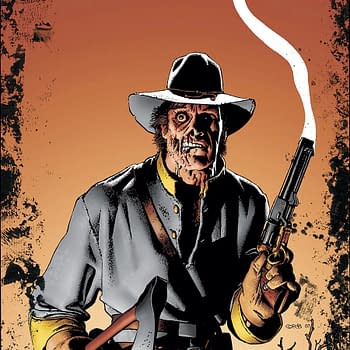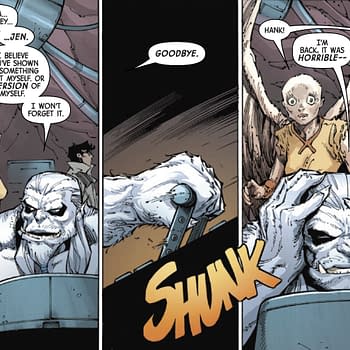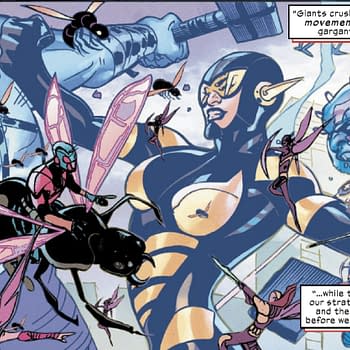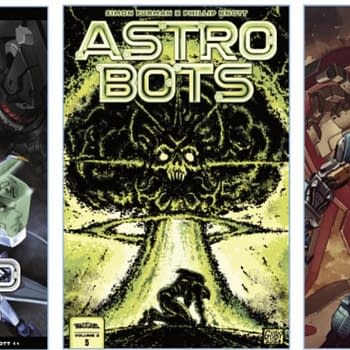Posted in: Comics | Tagged: 2020l, brian hibbs, comix experience, dc comics, san francisco
How DC Comics Chased Away Retailers- Brian Hibbs Looks Back on 2020
Brian Hibbs is the Owner of Comix Experience and Comix Experience Outpost comics shops in San Francisco, which he has owned and run for thirty-two years this year. He also runs the Graphic Novel of The Month book club, was one of the founders of ComicsPRO, famously led a successful million-dollar-plus Class Action lawsuit against Marvel Comics, and is a regular contributor to the Bleeding Cool Bestseller List.
This year, he held the line over speculator buyers, addressed the industry over the shutdown, planned to fix the direct market of comic book shops after the pandemic shutdowns, he held DC Comics publisher Jim Lee directly responsible, agreed with oft-rival Dennis Barger over the situation, Oh and in August he was hospitalized after suffering a heart attack. Quite the year.
In this year of major change, he has issued his annual sales report for 2020 and has allowed Bleeding Cool to reprint from it. You can read the whole thing here. The analysis runs below, without the Top 100 sales instore lists and similar. If any other comic stores would like to volunteer similar, contact richjohnston@bleedingcool.com. He writes;
No real surprise to anyone reading this, 2020 was kind of a bunk year! San Francisco was one of the first places in the United States to shut down commerce due to COVID — March 16th! — so we took it seriously, locally (during the Spanish Flu epidemic of 1918 we screwed it up massively, and I think that lingers, civically!), but man did it make for a pretty ugly year that we still have not recovered from. We launched a webstore very quickly (thank you Django Bohren and the users of the MOBY point of Sale on Facebook, for make it "easy"!) in early April, so that we could work twice as hard for half as much money — but it kept some cash flowing in. And we've made several changes in the time following (We're open for walk-ins, at a maximum of 20% capacity) to try and stem them bleeding — tighter store hours, much much tighter inventory, no longer playing along with publishers who want to abandon the market, etc. We've gotten grants, we've received PPP money, and, overall, we've kept it going through nearly sheer grit and determination and a TON of hard work from the amazing, amazing, AMAZING staff. We haven't cut staff hours, and we've actually managed to put in some raises for everyone (!!) thanks to the Graphic Novel Clubs, so I count this as a "success", even though the bottom line numbers are kind of terrifyingly bad and we're essentially hanging on by our fingertips.
The Mothership, on Divisadero, ended the year down a staggering 32.59% in income. Ugh. I mean, sure, that's way better than, say, May's 70%+ revenue drop, but it yielded the WORST year of sales since 1999! Wow! Ocean was down slightly more (-33.92%), but it's really pretty similar — people just are not into shopping and browsing in a time of plague, go figure, and that's not even considering all of the people who are out of work, or who have moved away from San Francisco in light of BigTech's "we don't actually need most of you inside offices, do we?" San Francisco is going to change DRAMATICALLY in 2021 and 2022, I think — this article says SF rents are down by a massive 35%, and the number of volume of empty and boarded-up retail storefronts in every neighborhood is truly heartbreaking — but we're working tirelessly to position ourselves so we can still be here on the other side, probably stronger and smarter than ever before.
I also think the Comics Market is going to change a lot, post-COVID (well, too early still to type that phrase, I guess — but at least I can SEE the possibility of the other side now) — as noted in my most recent "Tilting at Windmills", I truly don't think that DC Comics will be physically and personally publishing comics in the close future if only because they've stupidly broken the majority of their infrastructure and literally chased away the support of many many working retailers. But we're actively and thoughtfully trying to figure out how this new market is going to look and be shaped, and we're really hoping hard that we can continue to be a market leader to a new bold future.
As noted, we have two stores, both of which are very different in character and tone. The main, original store on Divisadero St. is fully a book-oriented store: some 64% of sales are from Graphic Novels and Trade Paperbacks; this percentage didn't change at all during the shut-down — it is exactly what it was in 2019. We also own a second location on the far south of The City, Comix Experience Outpost. The Outpost is a periodical-forward store, and is basic the reverse of the main one: 59% of its sales come from New periodicals (and another 14% from Old Comics). We've tried many things to try to broaden it's market, all to no avail. It did just 55% of the main store in sales, but it also has a lower overhead, so we make it work, mostly. However, it isn't really what one would call "profitable" on its own — honestly, it's a pretty break-even affair that we keep open largely because it would break my damn heart to close a comic shop in this environment. This is a TERRIBLE business decision, by the way, but I for sure am trying to make it so we don't have to lay off the hard working staff over there, or sadden all of the periodical readers on the South side of The City.
Let's take a look, store-by-store, at sales this year, and see what the best-sellers are in each category. Let's look at BOOKS, first, since that's the biggest category at the bigger store!
One important consideration here is that these numbers DO NOT include the Graphic-Novel-Of-The-Month Club numbers, every one of which would top the #1 in-store book! We've got some 265 members of the Adult GNC when we include the school accounts, about 400 now for the Kid's club, while the Comics Masterpieces Club has started slower at around 65 members — that sell multiple times the best-selling book sold to a walk-in customer. In fact, we've been told that, for at least some of the titles we selected the book club order is a meaningful percentage of sales, impacted sell outs or triggering further printings.
(If I am allowed to say, I think it is a SUPERB program, and I really invite you to JOIN TODAY! Each of these books ALSO have a LIVESTREAMED interview that goes with them, which you can find here). (I also can sell you pretty much all of these excellent books, and the adult ones all have author-signed bookplates, too! Go buy a few, wouldja?)
Again: NONE of the club copies are counted in here as "sales-to-walk-in-customers" – if we did, our Top 30 books would ONLY be these titles. So, at the Mothership on Divisadero (which I say again: book-forward comics shop), here are the Top 100 best-selling BOOKS — this is by NUMBER OF COPIES SOLD
The first observation I made is that of our Top 10 comics, SIX of them are by Asian creators, all doing American-style comics (so: not Manga). I do not believe that this has ever happened before?
My second observation is that, of the Top 100, at least FORTY of them are aimed explicitly at Younger Readers (and at least three more are "on the cusp") — this may be more of a function of COVID-era shopping than anything else, though.
My third observation is that while there are indeed several comics with Marvel/DC superheroes in them, I only immediately spot six of the Top 100 that are 1) "aimed at adults" and 2) "set in the current M/D universes"
All in all, this list seems like a pretty radical shift compared to what we're used to in a "normal" year. It will be interesting to see if this continues to play out once "full opening" happens (in the Fall?)

Our #1 book is SUPERMAN SMASHES THE KLAN, which is a somewhat happy surprise given it was also the kid's club selection (and, again, THIS list does NOT include Club selections) — the total number sold is significantly lower than our best-seller from 2019 (a bit under half), but my observation is that most of these copies appeared to be sold to children. It's a timely (if retro) book, but also a cracking good story on its own.
#2 is Adrian Tomine's LONELINESS OF THE LONG-DISTANCE CARTOONIST, which is not a shock to me at all — I knew this would do well with more casual GN readers.
#3 & #7 is MONSTRESS (with the earlier volumes down at 35 and 38) — it's a little unusual for a v4 to outsell a v1 (look at SAGA v1 coming in at #13, right?), but it is an unusual year
#4 is PILU OF THE WOODS, which also surprises me because this is about a year old — I'm thinking Zoe and Kat handsold that one a lot. Such a sweet book with a surprisingly deep and meaningful message, aimed sweetly at kids.
#5 is LITTLE BIRD in hardcover — the softcover is wildly down at #867, so I think people like the larger, more upscale presentation.
#6 is DISPLACEMENT by Kiku Hughes which only surprises me because this was released so late in the year — again, a lot of hand-selling on that one from Staff, as far as I can see.
#8 is the BOWIE book by Michael Allred. No surprise in San Francisco.
#9 is Brubaker and Phillips' PULP — I am quite sure that RECKLESS is going to top those sales this year. I interview them in a couple of weeks, and am looking forward to discussing why OGNs in a periodical world!
And finally, the Top ten is brought up at the end with Niki Smith's DEEP & DARK BLUE, and very Trans-friendly kids story in a city where that kind of book can hit big. Niki was one of the last signings we had in 2020 before the shutdown, though looking at it, it doesn't appear that that in particular is driving this number — these copies sold steadily over course of year.
Everything in our Top 20 sold at least the equivalent of 2 copies a month — but last year that was the entire Top 100 — down towards the bottom of the list it becomes more like "every six weeks"
There were nearly 4500 different graphic novels that we sold at least one copy of in 2020 at full retail price. Of course, we carry a bit closer to 6000, so that could do better… but without being able to BROWSE, selling many books is hard.
Since I have to pay staff and rent and electricity and all of the other myriad of costs to run stores, I usually actually think of stuff in terms of dollars sold, rather than units. Not going to do the entire top 100, but here's what the Top 20 looks like at Divis if you look at Dollars sold:
Yeah, then the Bowie book rockets into #1, and pricey hardcovers like HOUSE OF X POWERS OF X, SAGA, that Daniel Clowes "Artist Edition", the ZAP COMICS Box set and the INCAL zoom way way up the list. Even RECKLESS shows up, despite only being out for two weeks (and that $25 vs $17-for-PULP cover price tells you a story, as well)
If I sort out just the books, and look at publishers instead, here's what publishers-over-1%-of-dollars break out at, on the mothership… though again, none of this considers the GNC, just retail-trade-sales. "Everyone else" is just a bit over a quarter of sales — we're stocking what appears to be 313 different suppliers at the moment.
But what about the periodical on Divisadero? Well, it's a different picture for sure. Here's the Top 100 by number of copies sold, this should be properly and accurately adjusted to account for variant covers (small thing at Divis, bigger at Ocean)
I don't know that I have a ton of periodical notes this year — pretty much X-MEN and its satellites ruled the roost, while the main BATMAN title did similarly. For non-DC/Marvel titles, I see DECORUM #1 and NEGAN LIVES at #16, SEX CRIMINALS at #24 and 56, DEPARTMENT OF TRUTH and DUNE HOUSE ATREIDES at #56, MONSTRESS at #65, 81 and 90, LOVE AND ROCKETS at #74, and CRIMINAL at #81. Yikes, not a lot of penetration at the top this year, even while my perception is that the mid-list of non-superhero material has gotten significantly stronger this year.
Here is how the publishers break down by market share for us for periodicals (this is one is by dollars, with a cut off of 0.5%) . Mostly DC and Marvel sales are a whole lot of "subs +1" or "+2" for the rack. Because they're publishing so much rack filler the ironic thing is that they work against themselves — we'd sell so many more DC and Marvel comics if they'd just stop publishing so many damn comics. It's a rare book (25% of their output?) where I'm ordering what I'd consider a meaningful, or almost worth-the-effort to stock number of rack copies because the individual numbers are so low, the risk on unsold copies skyrockets. It's a goddamn conundrum for the working retailer. Anyway.
OK, lets switch over to Outpost, shall we? This one is a bit easier, and the focus over here is periodical comics. Here's the Top 100 comics for them.
It kills me just little bit, that Marvel/DC stranglehold. Everything about balance of stock that happens at Divis sure as hell doesn't happen here. They want what they want, and they will get it. You can't change what a customer base wants, you can only try to attractively provide many options of comics to buy; the problem that I see is that this store simply wouldn't be viable with a staff if it didn't have the mothership (and the GN Clubs!) holding it up. We will continue to try in 2021, though!
What do those numbers tell you? I dunno, really, but that's pretty much "Direct Market Store 101" right there for Outpost I think.
So, that's what 2020 looked like to me — a terribad yucky year, but one we've managed to keep ticking along because we just love comics too much to be logical and stop. Our staff is engaged, and, I want to believe, taken well care of despite the challenges that face the industry and our Beloved City. I do think that the Mothership will do fantastic after the lockdowns all end — and I think Outpost can keep muddling through. The two stores are about 3 miles apart, as the crow flies, but couldn't be more different in temperament or tone. Financially, the picture is struggling, but adequate — sales are uniformly down, and probably significantly more so than many parts of the country, and yet we've made living on the knife's edge, work alright. The clubs, especially the Kids Club, are thriving, so I see a lot of reason to be optimistic for the next decade.
(*knock wood*)
He also added on Facebook;
Retail talk! As a percentage of the wholesale cost of my weekly invoice, I paid the following in shipping costs to these wholesalers in 2020:
0.0% Hachette
0.0% HarperCollins
0.0% Houghton Mifflin-Harcourt
0.0% Macmillan
0.0% Penguin Random House
0.0% Scholastic
0.0% Simon & Schuster
0.7% Ingram
3.8% Lunar Distribution
9.7% Diamond Comics
I think this is a genuine problem for those last two companies.Some of these companies (like, say, Scholastic, with their minimum order of a paltry TEN books) are FOR SURE losing money shipping me product, even.
As I was just explaining to someone else, SOME of that is DC moving away from Diamond, so we fell out of the "hundred weight" shipping category many weeks.
How will 2021 break down?












